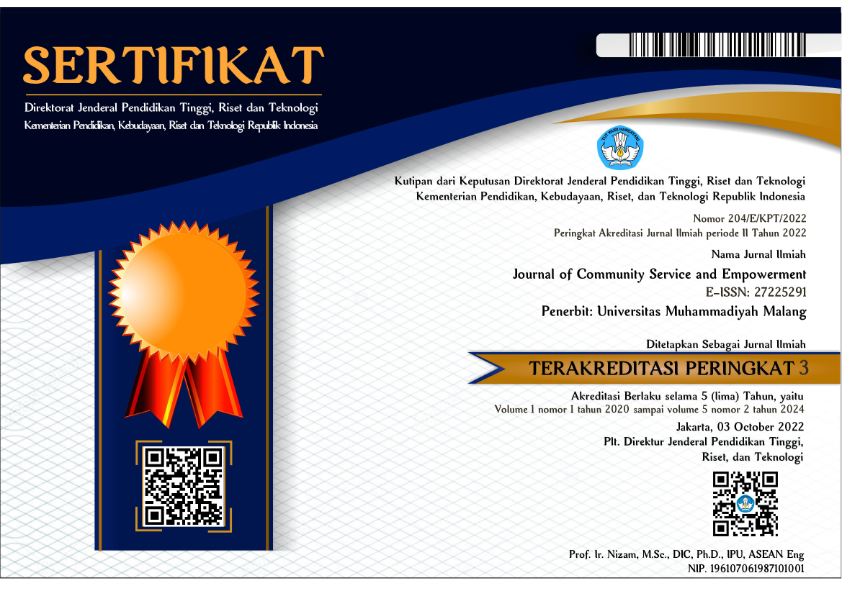Effective strategies to enhance awareness and proficiency in open wound emergency management for students
DOI:
https://doi.org/10.22219/jcse.v5i2.27253Keywords:
Awareness, Education, Open Wound Emergency, TransportationAbstract
Accidents can happen at home, school, day care center, or on the street at any time of the day. Children are prone to accidents or injuries because of their curiosity and vulnerability to accidents, especially at school. Accidents can include falls, choking on food, swallowing objects, electric shock, exposure to hot water, and drowning. The empowerment was carried out to increase the knowledge and skills of students in schools in providing first aid measures for open wounds. The activity was carried out at the Kota Kinabalu Indonesian School (SIKK) with 239 participants. The results of the activity showed an increase in knowledge and skills after being given education. Good knowledge and skills will improve health services and minimize the risk of injury. Similar activities can be carried out again with health topics and more diverse participants.
Downloads
References
Alfred, D., Chilton, J., Connor, D., Deal, B., Fountain, R., Hensarling, J., & Klotz, L. (2015). Preparing for disasters: Education and management strategies explored. Nurse Education in Practice, 15(1), 82–89. https://doi.org/10.1016/j.nepr.2014.08.001
Barredo, L., Agyepong, I., Liu, G., & Reddy, S. (2015). Ensure healthy lives and promote well-being for all at all ages. In UN Chronicle (Vol. 51, Issue 4). European Union. https://doi.org/10.18356/3bfe3cfa-en
Fallah Shayan, N., Mohabbati-Kalejahi, N., Alavi, S., & Zahed, M. A. (2022). Sustainable Development Goals (SDGs) as a Framework for Corporate Social Responsibility (CSR). In Sustainability (Vol. 14, Issue 3). https://doi.org/10.3390/su14031222
Fujita, Y., Shiono, Y., & Maki, K. (2014). Knowledge of emergency management of avulsed tooth among Japanese dental students. BMC Oral Health, 14(1), 34. https://doi.org/10.1186/1472-6831-14-34
Kim, J., Park, J.-H., & Shin, S. (2016). Effectiveness of simulation-based nursing education depending on fidelity: A meta-analysis. BMC Medical Education, 16(1), 152. https://doi.org/10.1186/s12909-016-0672-7
Ma, T., Peden, A. E., Peden, M., Hyder, A. A., Jagnoor, J., Duan, L., Brown, J., Passmore, J., Clapham, K., Tian, M., Rahman, A. K. M. F., & Ivers, R. Q. (2021). Out of the silos: Embedding injury prevention into the sustainable development goals. Injury Prevention, 27(2), 166–171. https://doi.org/10.1136/injuryprev-2020-043850
Nurlaela, E., & Mamluaty, A. N. (2020). Peningkatan pengetahuan mengenai pertolongan pertama pada perdarahan akibat luka cidera pada siswa sekolah dasar Muhammadiyah Bligo Kabupaten Pekalongan. Prosiding University Research Colloquium, 232–236.
Oktaviani, E., Feri, J., & Susmini, S. (2020). Pelatihan pertolongan pertama kasus kegawatdaruratan di sekolah dengan metode simulasi. JCES (Journal of Character Education Society), 3(2), Article 2. https://doi.org/10.31764/jces.v3i2.2368
Ranchhod, A., Gurău, C., Loukis, E., & Trivedi, R. (2014). Evaluating the educational effectiveness of simulation games: A value generation model. Information Sciences, 264, 75–90. https://doi.org/10.1016/j.ins.2013.09.008
Stafford, R. E., Morrison, C. A., Godfrey, G., & Mahalu, W. (2014). Challenges to the provision of emergency services and critical care in resource-constrained settings. Global Heart, 9(3), 319–323. https://doi.org/10.1016/j.gheart.2014.08.005
Suwardianto, H., & Rimawati, R. (2018). Explicit Instruction Model (EIM): Daily Training Emergencies Preparedness (DTEP) toward skills of participants the youth red cross. The 2nd Joint International Conferences, 2(2), 403–410.
Suwaryo, P. A. W. (2021). Bekali mahasiswa keterampilan kegawatdaruratan prodi keperawatan sarjana gelar BTCLS |. https://unimugo.ac.id/?p=3390
Suwaryo, P. A. W., & Yuda, H. T. (2019). leutikaprio.com—Kegawatan pada Kasus Trauma. http://www.leutikaprio.com/produk/110215/kesehatan/19111804/kegawatan_pada_kasus_trauma/191110040/putra_agina_widyaswara_suwaryo_hendri_tamara_yuda
Takian, A., Raoofi, A., & Haghighi, H. (2022). Chapter Nine - COVID-19 pandemic: The fears and hopes for SDG 3, with focus on prevention and control of noncommunicable diseases (SDG 3.4) and universal health coverage (SDG 3.8). In M. H. Dehghani, R. R. Karri, & S. B. T.-C.-19 and the S. D. G. Roy (Eds.), COVID-19 and the Sustainable Development Goals (pp. 211–234). Elsevier. https://doi.org/https://doi.org/10.1016/B978-0-323-91307-2.00014-6
WDT. (2023). Ensure healthy lives and promote well-being for all at all ages - Our World in Data. Our World in Data team. https://ourworldindata.org/sdgs/good-health-wellbeing
Wilks, J., Kanasa, H., Pendergast, D., Clark, K., Wilks, J., Kanasa, H., Pendergast, D., & Clark, K. (2015). Emergency response readiness for primary school children. Australian Health Review, 40(4), 357–363. https://doi.org/10.1071/AH15072
Xia, R., Li, S., Chen, B., Jin, Q., & Zhang, Z. (2020). Evaluating the effectiveness of a disaster preparedness nursing education program in Chengdu, China. Public Health Nursing, 37(2), 287–294. https://doi.org/10.1111/phn.12685

Downloads
Published
How to Cite
Issue
Section
License
Copyright (c) 2024 Putra Agina Widyaswara Suwaryo, Dadi Santoso, Hendri Tamara Yuda, Irmawan Andri Nugroho, H. Hariyady

This work is licensed under a Creative Commons Attribution-ShareAlike 4.0 International License.












